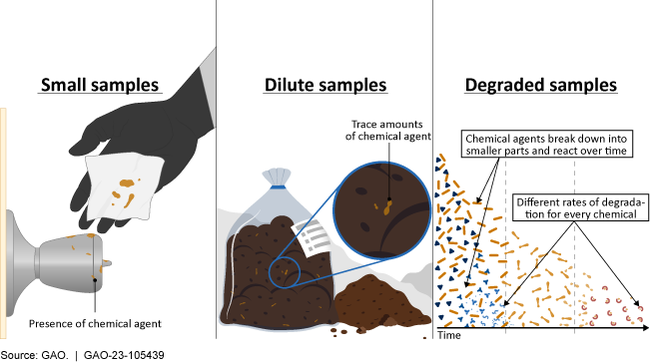Chemical Weapons: Status of Forensic Technologies and Challenges to Source Attribution
Fast Facts
Despite an international ban on their use, chemical weapons have been used over the past 10 years in assassinations and on civilian populations. When a chemical weapon is used, investigators may use forensic technologies to detect that it was used, identify the chemical, and help attribute it to a likely source.
Challenges to such investigations include small or degraded samples. These can result if investigators can't reach a site soon enough after an attack, or if it takes a long time to get samples to a lab.
We present 6 policy options to help decision makers address this and other challenges.
Some of the challenges of chemical analysis

Highlights
What GAO Found
When a chemical weapon is used, investigators may use forensic technologies to detect that it was used, identify the chemical, and help attribute it to a likely source. Most technologies for chemical identification are mature. Some technologies for attributing chemical agents based on chemical analyses are under development. For example, a wide variety of laboratory-based and fieldable instruments for chemical identification are in commercial use. Investigators also use data from these instruments to help attribute chemicals to their potential sources, but there are limits to the information existing technologies can provide.
Key technologies to identify and attribute chemical weapons to a likely source
| Technology | Information it provides |
|---|---|
| Chromatography (Gas or Liquid) | Separates and identifies chemicals in a sample mixture. Mature for identification of chemical agents, can inform attribution. |
| Nuclear Magnetic Resonance Spectroscopy | Determines arrangement of atoms in a molecule. Mature for identification of chemical agents, developing for complex mixtures. Can inform attribution. |
| Mass Spectrometry | Measures mass-to-charge ratios to identify chemicals in a mixture. Mature for identification of chemical agents, can inform attribution. |
| Impurity Profiling | Identifies key impurities to link samples to production process or precursor. In development for attribution. |
| Isotope Ratio Methods | Measures ratio of stable isotopes in a sample to link to a precursor. In development for attribution. |
Source: GAO. | GAO-23-105439
GAO found several challenges that can hinder identification and attribution of chemical agents, including the following:
- Poor samples: In some instances, investigators cannot obtain useful chemical information because samples are too small, dilute, or degraded.
- Limited reference data: Generally, chemical identification methods rely on comparison to data from known chemicals, called reference data. However, reference data can be limited because they are resource intensive to collect, analyze, and archive. Additionally, reference data may be challenging to use in some instances, such as if they were developed using different experimental methods or stored in an incompatible format.
- Lack of information sharing: Controls on information sharing are needed for national security concerns but can hinder collaboration among researchers in developing technologies and improving understanding of chemicals and their sources.
- Limited coordination: Entities may not be aware of individual and laboratory expertise that could assist with identifying a chemical agent or its source. Researchers may unknowingly duplicate work, and opportunities to strengthen capabilities may be missed.
GAO identified six high-level policy options in response to these challenges. These policy options are provided to inform policymakers of potential actions to address the challenges identified in this technology assessment. They identify possible actions by policymakers, which include Congress, federal agencies, state and local governments, academic and research institutions, and industry.
Policy options to address challenges that hinder identification and attribution of chemical agents
| Policy Option | Opportunities | Considerations |
|---|---|---|
| Develop technology to aid with sampling (report p. 35) Policymakers could encourage development of technologies that allow more rapid sample analysis or that slow sample degradation. |
|
|
| Study known threats (report p. 36) Policymakers could advance scientific knowledge on known chemical agents and threats. |
|
|
| Further anticipate emerging threats (report p. 37) Federal policymakers could foster development of technologies and approaches that help anticipate emerging chemical threats. |
|
|
| Standardize data (report p. 37) Policymakers could encourage standardization of future data collection and support efforts to modernize legacy data on chemical threats. |
|
|
| Share information (report p. 38) Federal and international policymakers could facilitate information sharing to increase collaboration on chemical agent forensic analyses. |
|
|
| Coordinate on chemical attribution (report p. 40) Federal and international policymakers could encourage increased coordination between entities involved in chemical attribution. |
|
|
Source: GAO. | GAO-23-105439
Why GAO Did This Study
Despite the Chemical Weapons Convention's ban on their use, chemical weapons have been used in the past decade in assassinations and on civilian populations. To identify the use of a chemical weapon and then attribute that weapon back to its source, researchers rely on several technologies for chemical analysis. Chemical analysis is one piece of an overall chemical weapon investigation.
This report discusses (1) the status of key technologies available to identify a chemical agent or its source, including their strengths and limitations; (2) challenges researchers and investigators face in trying to identify a chemical agent or its source; and (3) policy options that may help address the challenges of using key technologies to identify a chemical agent and its source.
To conduct this technology assessment, GAO reviewed key reports and scientific literature; interviewed government, intergovernmental, and academic representatives; conducted site visits; and convened two meetings of experts with the assistance of the National Academies of Sciences, Engineering, and Medicine. GAO is identifying policy options in this report.
For more information, contact Karen Howard at (202) 512-6888 or HowardK@gao.gov.
